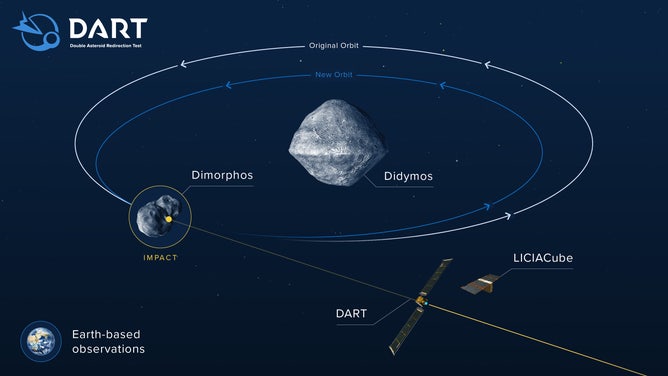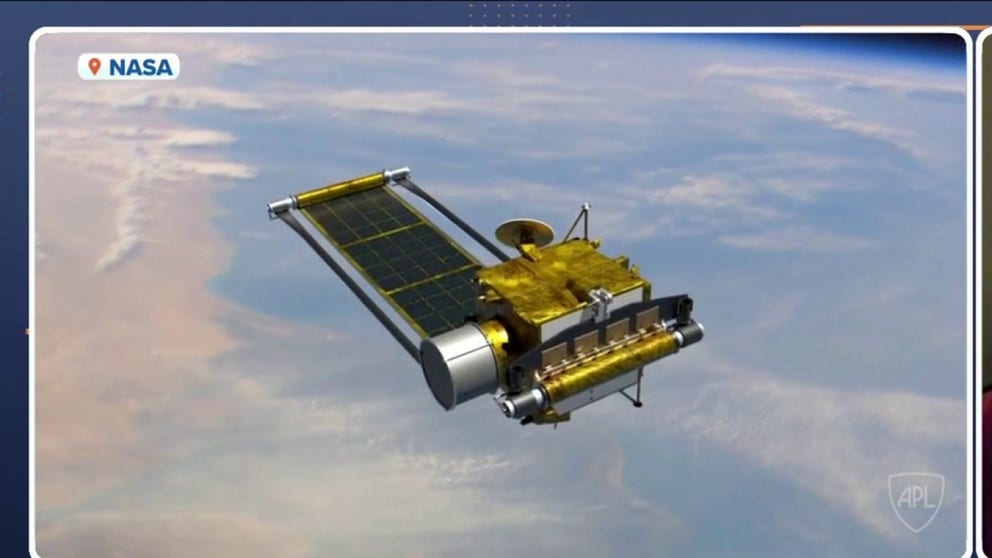Why 'Armageddon' plot is not Earth's best defense from asteroids
Blowing up a Texas-size asteroid to make more asteroids is not going to cut it.
Testing Out Earth's Planetary Defense Plan
NASA's DART spacecraft is one part of a global effort to protect Earth if a large asteroid is headed out way.
NASA is preparing to test a plan that could protect Earth years before city-sized asteroid slams into our planet, unlike the plot of "Armageddon" with a 12-day timeline to save us all.
This test mission does not involve sending Bruce Willis and a crew of hot shots to land on and blow an asteroid up into bits and pieces. Why? Because, according to planetary science and fundamental physics, the plot of the 1998 film would not be a good option if and when a giant space rock is headed toward our planet.
A SpaceX Falcon 9 rocket launched NASA's Double Asteroid Redirect mission known as DART last year, from Vandenberg Air Force Base in California. The objective of the spacecraft is to slam into a small asteroid or moonlet called Dimorphos, which is orbiting a half-mile-wide asteroid called Didymos, and change the speed of that moonlet by at least 73-seconds.
The asteroids are gravitationally bound to each other. When DART hits Dimorphos, it will slightly change how the pair orbit the sun but only by a tiny amount, according to DART investigation team lead Andy Cheng, with the Johns Hopkins Applied Physics Laboratory.
Models indicate the shove by the spacecraft should change it much more than 73 seconds, but here's why they are not aiming to blow the asteroid into smithereens and instead give it a hard push.
7 THINGS TO KNOW ABOUT NASA’S DART MISSION
"Asteroids are complicated, they look different, they've got boulders, they've got rocky paths, they've got smooth parts," DART Coordination Lead Nancy Chabot said. "And so how exactly the DART spacecraft interacts with a real asteroid of this size and where it hits is one of the main factors for those models and also how that asteroid is put together. We know a lot of asteroids are maybe like rubble piles."
Researchers want to find out how much of this "rubble pile" gets ejected into space and the reaction to a real asteroid.
Another reason why Michael Bay's "Armageddon" movie doesn't add up is because NASA and its international partners are tracking potential threats to Earth. If an asteroid the size of Texas were coming, NASA would know years in advance, not just two weeks like in the science-fiction thriller.
NASA's Planetary Defense Coordination Office continues to use ground-based telescopes to look for asteroids. While about 27,000 near-Earth asteroids have been identified, there are still more out there. According to NASA, about 40% have been identified.
NASA'S SPACECRAFT WILL RENDEZVOUS WITH RARE ASTEROID COMING CLOSE TO EARTH
Even the term "near" is relative in the context of space. A near-Earth object is anything within 30 million miles of Earth. If it comes within 5 million miles, that's when NASA begins tracking it.
The key to an excellent planetary defense strategy is time.
NASA Planetary Defense Officer Lindsey Johnson said the best time to deflect an asteroid is as far away from Earth as we can.
"The strategy is to find these objects not only years but decades before they're any kind of an impact hazard to the Earth. So we have time to characterize them first and know where they're going to be headed," Johnson said.
If researchers can identify the asteroid and determine its size and composition, they will know the best method to change its orbit.
HOW ASTRONOMERS KNEW EXACTLY WHERE A SMALL ASTEROID WOULD IMPACT EARTH
"The further away in space, years before the impact, the less force it takes to change the orbit enough that it will be a miss instead of a hit," Johnson said.
While Didymos and Dimorphos are not threats to Earth, NASA selected the binary asteroids because the space rocks are relatively close to Earth. Ground-based telescopes can observe the pair, including tracking any change after DART completes its mission.

A rendering of the DART spacecraft and the asteroid pair, Didymos and Dimorphos.
(NASA)
Chabot said the team chose the asteroid duo because it is a common type of asteroid in the near-Earth object population.
"It's actually 4.5 billion years old. It formed before the planets formed. It's like the leftovers of planets formation. So that actually makes this asteroid system a really good test in order to do this as well," Chabot said.
This is why DART makes a good test that could be applied to other near-Earth asteroids.
A European Space Agency mission called HERA will launch in 2024 and get a close-up look at DART's impact site.
CLICK HERE TO GET THE FOX WEATHER UPDATE PODCAST
In the last decade, NASA, the Japanese Space Agency, and the European Space Agency have conducted robotic missions to different asteroids, and more are planned in the next ten years. Japan has collected two samples from asteroids, and NASA's OSIRIS-REx spacecraft is bringing home the first for the U.S.
These missions have proven that spacecraft can perform precise navigation around a rock hurtling through space at 20 miles per second. Meaning, Ben Affleck and crew could sit this one out. It's unlikely an astronaut team would be called up to land on an asteroid.
The $330 million DART mission might be the first of a planetary defense strategy. Still, the more planetary scientists know about different classes of asteroids, the better humans will be prepared to defend the only planet we call home.
